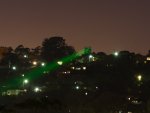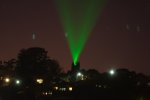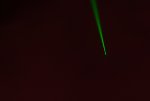Hi all, just joined up. Heres some pics of my 100mw green, shining it through a 6 inch telescope to get a wider beam but with much less divergence, focussing on a watertank a few Kms away. Image taken with a 300mm lens. I moved the laser round the eyepiece of the scope to "draw" the pattern on the tank.

Welcome to Laser Pointer Forums - discuss green laser pointers, blue laser pointers, and all types of lasers
How to Register on LPF | LPF Donations
Navigation
Install the app
How to install the app on iOS
Follow along with the video below to see how to install our site as a web app on your home screen.
Note: This feature may not be available in some browsers.
More options

You are using an out of date browser. It may not display this or other websites correctly.
You should upgrade or use an alternative browser.
You should upgrade or use an alternative browser.
Long range laser through a telescope
- Thread starter tornado33
- Start date


Here is another pic this time firing the laser through the 6 inch telescope's finderscope while photographing through the telescope.
Note, I was taking great care NOT to even briefly aim anywhere near the houses or people. Because the beam is so wide when fired through the 6 inch scope, from more of a distance to the side its invisible. When fired through the finderscope it is only about 1/2 inch wide, hence the larger spot is paints on the tank. As the finder is close to the main scope the beam loots so wide. Anyone wanting to tty this dont do it anywhere near rods or aircraft as the beam goes much further then just the laser on its own.
Note, I was taking great care NOT to even briefly aim anywhere near the houses or people. Because the beam is so wide when fired through the 6 inch scope, from more of a distance to the side its invisible. When fired through the finderscope it is only about 1/2 inch wide, hence the larger spot is paints on the tank. As the finder is close to the main scope the beam loots so wide. Anyone wanting to tty this dont do it anywhere near rods or aircraft as the beam goes much further then just the laser on its own.
Attachments
T
timelord
Guest
Re: Long range laser through a telescope
Great shots tornado33 nice to have another astronomer on board our forum
Great shots tornado33 nice to have another astronomer on board our forum
Re: Long range laser through a telescope
How long is long ?
As a demonstration it would be nice to do some long range photos with the laser
by itself,
through the view finder
and through the telescope proper,
minus the squigglies.
On objects of increasingly known distances. Hope you do this.
Recently with my alpha 105 laser of average output 121mw's, as a reference I will shine it on a water tower approx. >29,000 feet away and view the spot with a 30X50 spotting scope. Too my surprise I was unable to see any indication of reflected light. It surprised me because with a 26.3 mw laser that had the optic system modded for a lower beam divergence I was able to see reflected light. The conclusion is if you want a laser that projects a visible spot at great distance lower beam divergence is a must have.
How long is long ?
As a demonstration it would be nice to do some long range photos with the laser
by itself,
through the view finder
and through the telescope proper,
minus the squigglies.
On objects of increasingly known distances. Hope you do this.
Recently with my alpha 105 laser of average output 121mw's, as a reference I will shine it on a water tower approx. >29,000 feet away and view the spot with a 30X50 spotting scope. Too my surprise I was unable to see any indication of reflected light. It surprised me because with a 26.3 mw laser that had the optic system modded for a lower beam divergence I was able to see reflected light. The conclusion is if you want a laser that projects a visible spot at great distance lower beam divergence is a must have.
Re: Long range laser through a telescope
yes you have to make the beam larger to reduce the divergance. The lasers thay shoot at the moon go through 3.5 meter ( 10 feet ) wide telescopes and the beam is still >4 miles wide on the moon. that equates to roughly a .004 mrad divergance.
yes you have to make the beam larger to reduce the divergance. The lasers thay shoot at the moon go through 3.5 meter ( 10 feet ) wide telescopes and the beam is still >4 miles wide on the moon. that equates to roughly a .004 mrad divergance.
Re: Long range laser through a telescope
Laser ranging of the Moon
1/3600th of a degree = .277 milliradian
More
http://physics.ucsd.edu/~tmurphy/apollo/basics.html
Laser ranging of the Moon
The telescope used for APOLLO has a 3.5 meter diameter mirror, and is located at the Apache Point Observatory in southern New Mexico. We use the telescope as a gigantic (3.5 meter wide) laser pointer and also as a signal receiver. We reference our measurements to the center of the telescope mount, where the azimuth axis and elevation axis intersect each other. As the telescope swings around to point at different parts of the sky, this point stays fixed—almost.... The position of the telescope relative to the center of the earth isn't as stationary as you might imagine. The continental plate drifts, the tides from the moon and sun make the site swell by about a foot twice a day, weather systems can push the local crust down, etc. We have to be aware of all of these influences and take them into account in order to extract the scientifically useful center-to-center distance between the earth and moon.
To concentrate as much laser power as possible onto the reflector array, we must ensure that the beam leaving the telescope is as collimated (parallel, non-diverging) as possible. We use a laser both because we can get ultra-short pulses of light from a laser, and also because the light from a laser is extraordinarily directional—not diverging the way a flashlight, or even searchlight, would. Even so, the turbulent atmosphere distorts the beam, imparting a divergence of about one arcsecond (sometimes more). One arcsecond is 1/3600th of a degree, or the angular size of a quarter about five kilometers (about 3 miles) away. At the distance of the moon, this angle translates to 1.8 kilometers (just over a mile). Though this is large compared to the size of the reflector (most of the light is wasted—never hitting the reflector), it is still a challenge to point and maintain the laser beam on this tiny patch of the moon.
1/3600th of a degree = .277 milliradian
More
http://physics.ucsd.edu/~tmurphy/apollo/basics.html
Gazoo
0
- Joined
- Jun 9, 2007
- Messages
- 3,206
- Points
- 38
Re: Long range laser through a telescope
It looks like a death ray in the first pic... ;D Very nice..
It looks like a death ray in the first pic... ;D Very nice..
Thanks all.
The distance from my place to the watertower is pretty close to 2.5 kms. I also have a 10 inch telescope, and yes a futile effort but I tried to reach the laser reflector of Apollo 15, by shining it at what I thought was the correct spot during the recent lunar eclipse, then taking the laser away and looking for a return flash (takes light about 2 secs to get there) but saw nothing. 2 reasons,
1 I read somewhere that one needs at least 2 full watts of laser power, and also
2 hitting such a small spot on the moon would be pretty tough just hand holding the laser at the telescope eyepiece.
Heres a pic of the laser striking cloud, again shone through the 6 inch scope, photographed with 300mm lens. Note the bright starlike spot where it strikes the cloud
The distance from my place to the watertower is pretty close to 2.5 kms. I also have a 10 inch telescope, and yes a futile effort but I tried to reach the laser reflector of Apollo 15, by shining it at what I thought was the correct spot during the recent lunar eclipse, then taking the laser away and looking for a return flash (takes light about 2 secs to get there) but saw nothing. 2 reasons,
1 I read somewhere that one needs at least 2 full watts of laser power, and also
2 hitting such a small spot on the moon would be pretty tough just hand holding the laser at the telescope eyepiece.
Heres a pic of the laser striking cloud, again shone through the 6 inch scope, photographed with 300mm lens. Note the bright starlike spot where it strikes the cloud
Attachments
- Joined
- Aug 15, 2007
- Messages
- 1,880
- Points
- 0
I imagine a plane flying over the cloud and seeing bright green patch below... Pilot "What the F_CK is that????" passengers "hey cool, a green cloud. aliens r here wooo" ;D
**edit** removed F-bomb {SenKat}
**edit** removed F-bomb {SenKat}
Re: Long range laser through a telescope
You'll never see a return flash that way. Even with the current 3.5 meter telescope it is difficult. I posted a link within this thread on the current lunar ranging project.
tornado33 said:Thanks all.
The distance from my place to the watertower is pretty close to 2.5 kms. I also have a 10 inch telescope, and yes a futile effort but I tried to reach the laser reflector of Apollo 15, by shining it at what I thought was the correct spot during the recent lunar eclipse, then taking the laser away and looking for a return flash (takes light about 2 secs to get there) but saw nothing. 2 reasons,
1 I read somewhere that one needs at least 2 full watts of laser power, and also
2 hitting such a small spot on the moon would be pretty tough just hand holding the laser at the telescope eyepiece.
Heres a pic of the laser striking cloud, again shone through the 6 inch scope, photographed with 300mm lens. Note the bright starlike spot where it strikes the cloud
You'll never see a return flash that way. Even with the current 3.5 meter telescope it is difficult. I posted a link within this thread on the current lunar ranging project.




